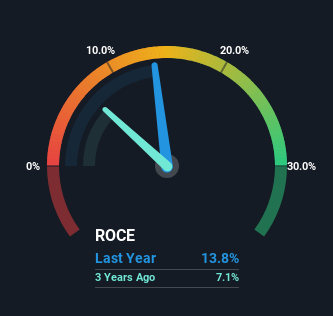Ricegrowers (ASX:SGLLV) Hasn't Managed To Accelerate Its Returns
If we want to find a stock that could multiply over the long term, what are the underlying trends we should look for? Firstly, we'll want to see a proven return on capital employed (ROCE) that is increasing, and secondly, an expanding base of capital employed. Basically this means that a company has profitable initiatives that it can continue to reinvest in, which is a trait of a compounding machine. However, after briefly looking over the numbers, we don't think Ricegrowers (ASX:SGLLV) has the makings of a multi-bagger going forward, but let's have a look at why that may be.
Return On Capital Employed (ROCE): What Is It?
For those that aren't sure what ROCE is, it measures the amount of pre-tax profits a company can generate from the capital employed in its business. Analysts use this formula to calculate it for Ricegrowers:
Return on Capital Employed = Earnings Before Interest and Tax (EBIT) ÷ (Total Assets - Current Liabilities)
0.14 = AU$87m ÷ (AU$1.3b - AU$700m) (Based on the trailing twelve months to April 2023).
Thus, Ricegrowers has an ROCE of 14%. On its own, that's a standard return, however it's much better than the 5.5% generated by the Food industry.
Check out our latest analysis for Ricegrowers
In the above chart we have measured Ricegrowers' prior ROCE against its prior performance, but the future is arguably more important. If you'd like to see what analysts are forecasting going forward, you should check out our free report for Ricegrowers.
How Are Returns Trending?
Over the past five years, Ricegrowers' ROCE and capital employed have both remained mostly flat. This tells us the company isn't reinvesting in itself, so it's plausible that it's past the growth phase. So don't be surprised if Ricegrowers doesn't end up being a multi-bagger in a few years time. With fewer investment opportunities, it makes sense that Ricegrowers has been paying out a decent 45% of its earnings to shareholders. Given the business isn't reinvesting in itself, it makes sense to distribute a portion of earnings among shareholders.
On a side note, Ricegrowers' current liabilities are still rather high at 53% of total assets. This can bring about some risks because the company is basically operating with a rather large reliance on its suppliers or other sorts of short-term creditors. Ideally we'd like to see this reduce as that would mean fewer obligations bearing risks.
In Conclusion...
In summary, Ricegrowers isn't compounding its earnings but is generating stable returns on the same amount of capital employed. Since the stock has gained an impressive 50% over the last five years, investors must think there's better things to come. But if the trajectory of these underlying trends continue, we think the likelihood of it being a multi-bagger from here isn't high.
On a final note, we found 2 warning signs for Ricegrowers (1 is potentially serious) you should be aware of.
While Ricegrowers isn't earning the highest return, check out this free list of companies that are earning high returns on equity with solid balance sheets.
Have feedback on this article? Concerned about the content? Get in touch with us directly. Alternatively, email editorial-team (at) simplywallst.com.
This article by Simply Wall St is general in nature. We provide commentary based on historical data and analyst forecasts only using an unbiased methodology and our articles are not intended to be financial advice. It does not constitute a recommendation to buy or sell any stock, and does not take account of your objectives, or your financial situation. We aim to bring you long-term focused analysis driven by fundamental data. Note that our analysis may not factor in the latest price-sensitive company announcements or qualitative material. Simply Wall St has no position in any stocks mentioned.

